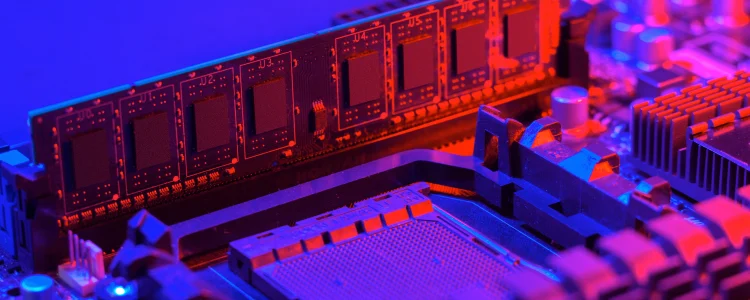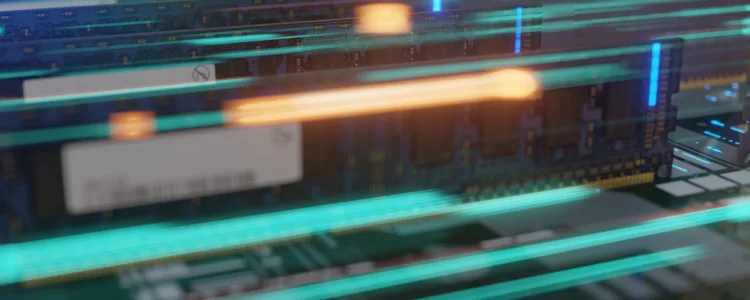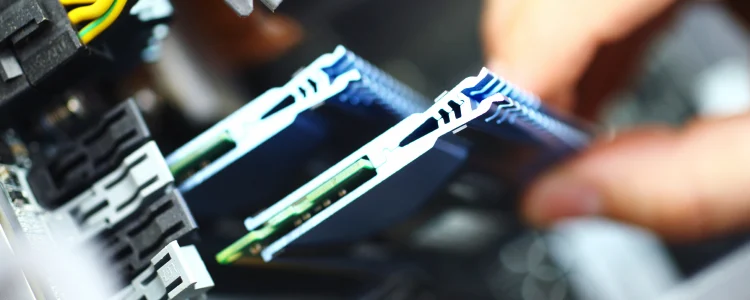DDR4 vs. DDR5 RAM – Should you Upgrade?

DDR5 RAM vs. DDR4 RAM is the latest debate in the tech world. With the latest version of RAM available, everyone is eager to know which one is better and which one they should invest in. If you have been wondering about the differences between these two RAM versions, you have come to the right place. In this article, we’ll explore the differences between DDR5 RAM and DDR4 RAM to help you decide which is best for your system.

What is DDR5 RAM?
With the launch of Intel’s 12th Generation Core CPUs, led by the Core i9-12900K, and related Z690-chipset motherboards, DDR5 became the newest memory standard for mainstream PCs. DDR5 memory chips help to improve signal integrity for the command and address signals sent from the host memory controller to the DIMMs. The main goal of this version is to reduce RAM’s power consumption while boosting its capacity and performance.
In contrast to earlier memory technologies, which were mostly pushed by applications for mobile devices and data centers, DDR5’s performance enhancement was primarily driven by increased memory bandwidth. DDR5 is built with additional capabilities for faster speed, less power consumption, and more reliable data integrity.
Features of DDR5 RAM
Double Data Rate 5 (DDR5) RAM is the most recent memory technology standard, providing better performance and capacity than DDR4 RAM. However, some of the features that make DDR5 RAM stand out include the following:
Greater starting speed performance
DDR4 has a top speed of 3200MT/s, while DDR5 starts at 4800MT/s*. The bandwidth has increased by 50% as a result. The performance of DDR5 is expected to increase to 6400MT/s in sync with the releases of new technology.
Reduced power / increased efficiency
Compared to DDR4 equivalent components at 1.2V, DDR5 uses about 20% less power at 1.1V. However, this significantly benefits 24/7 enterprise servers and helps preserve battery life in laptops.
PMIC
Power Management Integrated Circuits (PMIC) are built into DDR5 modules to help manage the power used by the memory module’s various components (DRAM, register, SPD hub, etc.). The PMIC uses 12V for modules designed for servers and 5V for PC-class modules. This results in better power distribution, enhanced signal integrity, and lower noise than earlier generations.
SPD hub
DDR5 uses a new device to manage access to the external controller, decouple the external bus’s memory load from the exterior, and manage the Serial Presence Detect (SPD) EEPROM.
Dual 32-bit subchannels
DDR5 divides the memory module into two separate 32-bit addressable subchannels to boost performance and reduce data access latencies for the memory controller. The DDR5 module’s data width is still 64 bits.
However, dividing it into two 32-bit addressable channels improves overall performance. To support ECC, 8 bits are added to each subchannel in server-class memory (RDIMMs), totaling 40 bits per subchannel or 80 bits per rank with 32-bit subchannels in dual-rank modules.
See also: RAM vs. SSD – What’s the difference between memory and storage?

What is DDR4 RAM?
DDR SDRAM 4 was introduced when DDR3 reached its limits with more demand for greater performance and bandwidth. DDR4 offers better data integrity, lower power consumption, higher DIMM capacities, and improved performance than DDR3 RAM.
DDR4 (DDR4 Low Voltage) offers up to 50% more performance and bandwidth while using less power than DDR3L (DDR3 Low Voltage) and also reducing the power consumption of your entire computing environment. DDR4 can achieve more than 2Gbps per pin. This is a significant advancement over earlier memory technologies and can save up to 40% on power.
DDR4 offers improved signal integrity, cyclic redundancy checks (CRC) for improved data reliability, on-chip parity detection for integrity verification of “command and address” transfers over a link, and other strong RAS features in addition to optimized performance and more environmentally friendly, low-cost computing.
Features of DDR4 RAM
Some of the features of DDR4 RAM we will be considering include the following:
Increased Bandwidth
The speed of DDR4 is faster and starts at 2133MHz, which would be considered high-end for DDR3. The planned speed increases may push it well past 3200MHz. In turn, users use less energy and can complete more work quickly.
Reduced power consumption
DDR4 is more energy-efficient than DDR3, using up to 40% less energy. Compared to DDR3 RAM, which requires 1.5V to operate, DDR4 RAM operates at 1.2. As a result, the system’s overall power consumption is decreased because less power is needed to run the RAM.
Increased capacity
The capacity of DDR4 RAM is up to four times greater than that of DDR3 RAM, allowing users to store more data while utilizing fewer chips. This reduces power consumption, and single memory modules with capacities as high as 512GB may be possible with DDR4 because it supports higher-density chips and stacking technologies.
Error-Correcting Code (ECC)
Data faults are detected and fixed by DDR4 RAM’s built-in error-correcting code before it is written to or read from the memory module. Consequently, data loss caused by errors is reduced and prevented.
Why the need for DDR5 RAM?
Before DDR5 RAM was released on November 4, 2021, DDR4 was the latest version of DDR, and it offers up to 16 GB of memory capacity per RAM chip, 3.2 Gb/s data transfer rates, and 1.2V power requirements.
But when data-intensive applications like streaming, video conferencing, online gaming, data analytics, and AI/ML apps proliferate, DDR4 cannot catch the pace.
Hyperscale data centers have dramatically increased due to the business world’s move of workloads to the cloud from on-site locations. DDR5 RAM offers significant server performance gains in response to these mounting difficulties.
Compared to earlier versions, DDR5 RAM has the following notable benefits:
- Increased memory capacity: The memory speed and capacity of DDR4 RAM chips range from 2 GB to 16 GB, while that of DDR5 RAM chips range from 8 GB to 64 GB.
- Increased bandwidth: DDR5 has a minimum data transfer speed of 4.8 Gb/s and a 50%+ improvement in bandwidth over DDR4 (3.2 Gb/s).
- Low voltage requirements: While DDR4 requires 1.2V to operate, DDR5 needs 1.1V. Using less power results in less heat being produced, which improves server performance. Server performance suffers the most when a greater heat buildup is not dissipated.
- New power architecture: With DDR5 DIMMs, power management is transferred from the motherboard to the DIMM. These DIMMs contain a 12V power management integrated circuit (PMIC), which reduces the margin of loss caused by a lower operating voltage and lessens signal integrity and noise problems.
- Updated channel architecture: DDR4 DIMMs have a 72-bit channel that contains 64 data bits and eight ECC bits. Error correction code (ECC) is a tool for identifying and fixing data damage in memory. Each of the two channels on DDR5 DIMMs is 40 bits wide and consists of 32 data bits and 8 ECC bits. This enhances the effectiveness of memory access.
- Longer burst length: While DDR5 has a burst chop of 8 bits and a burst length of 16, DDR4 has a burst length of 8 bits and a burst chop of 4. Burst length is the volume of data transferred; burst chop refers to the quantity of data transferred in part. Both burst length and burst chop helps to improve concurrency and memory efficiency.

Difference between DDR5 and DDR4
Let’s look at the differences between DDR5 vs. DDR4 in a tabular form.
| Specification | DDR5 Memory | DDR4 Memory |
|---|---|---|
| PCB Color | Black | Green |
| Component Density | 8Gb/16Gb | 8Gb/16Gb-8Gb/16Gb-16Gb |
| Module Rank and Configuration | 1Rx8/1Rx16-2Rx8/1Rx8-2Rx8 | 1Rx8/1Rx16-2Rx8/1Rx8-2Rx8 |
| System Bandwidth3 | 69.2 GB/s | 33.6 GB/s |
| Operative Voltage | 1.1V | 1.2V |
| Support for Intel XMP 3.0 and AMD EXPO9 | Yes, supports both on the same module | – |
| System Latency | 92.8 ns | 90.0 ns |
| Module Density | 8GB-16GB-32GB | 8GB-16GB-32GB |
| Standard Speed | 5600MT/s | 3200MT/s |
| Channel Architecture | Two independent 32-bit channels | One 64-bit channel |
| Compatibility | For DDR5 systems only | For DDR4 systems only |
| Power Management | On-module | On-motherboard |
| Burst Length | 16 | 8 |
| Pin Count & Notch Position | UDIMM: 288-pins SODIMM: 262-pins | UDIMM: 288-pins SODIMM: 260-pins |
| On-die ECC (ODECC)12 | Yes | – |
| Banks Groups | 8 | 4 |
| Refresh Schemes | 75% of the banks are accessible during refresh | None are available during refresh |
| Banks | 64 | 32 |
Should you upgrade?
Upgrading from DDR4 RAM to DDR5 RAM depends on your needs and your computer type. DDR5 RAM is the latest version of RAM technology, offering several advantages over DDR4 RAM. Upgrading to DDR5 RAM can be worthwhile if you are a hardcore gamer or a professional who needs extra data storage options for business.
Compared to DDR4 RAM, DDR5 RAM offers faster data transfer speeds, lower latency, and more capacity. Also, it uses less energy and generates less heat, which is advantageous in some applications. However, if you do not require the extra performance, switching to DDR5 RAM might not be beneficial due to its high cost. The best way to decide whether to upgrade is to evaluate the performance of your system (best for AMD processors) and whether you require the extra performance that DDR5 RAM may offer.
Conclusion
Anyone seeking optimum performance from their PC should carefully consider the differences between DDR4 and DDR5 RAM. While DDR4 RAM provides excellent performance and stability, DDR5 RAM is the easy pick for those seeking the best gaming experience because it has the potential to provide even higher performance. The decision between DDR4 and DDR5 RAM ultimately comes down to the user’s needs, budget, and hardware options.
However, you will need a storage server regardless of which RAM version you choose. ServerMania offers storage server hosting that allows you to store a small amount of data for personal backups or hundreds of terabytes for enterprise data storage. Check out our Storage Server Deployment Guide today and get started on a tailored solution for your new DDR RAM.
Was this page helpful?

